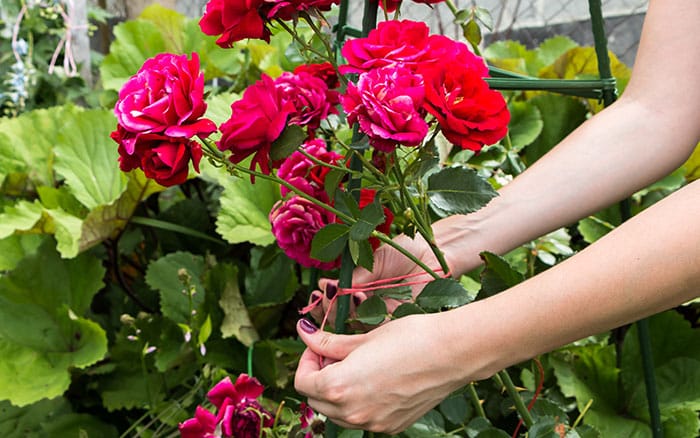Spring has finally arrived, bringing floral delights and a whole new set of fresh leaves to gardens everywhere.
If you have climbing or rambling roses, now’s the time to check the stems are properly tied in and secure. This way, they won’t suddenly spring free (excuse the pun).
Newly planted roses
If you’ve recently planted a climber or rambler, check the support structure it’s growing against. It must be strong enough to hold the long stem growth that will come over the next few months.
There are many support options. Your choice depends on how vigorous the rose is and how formal you want it to look. Short climbers can be trained up obelisks or pillars. These structures work well, provided they’re tall enough for the rose’s full height.
Keep tying in new stems as they grow to keep your rose neat and to support even growth.

Training against a wall
Training against a wall is ideal for most climbers and for less vigorous ramblers. It’s a great way to create vertical interest and manage growth.
One of the easiest methods is to screw 50–75mm screws into the mortar between bricks at regular intervals. You can then tie the rose stems directly to these screws using string or another suitable tying material.
Continue tying in new shoots as they appear. This helps with long-term training and keeps everything secure and tidy.

Training vertically or horizontally
Remember that stems trained horizontally or at an angle will produce more side shoots and so more flowers than those trained vertically. A rose-covered arch is a classic; make sure it’s the right size for the variety.
If you want flowers at the bottom and all the way up the arch, stem placement is very important. The stems must be flexible enough to bend without snapping or causing damage to the plant.
Start by twizzling some of the stems gently around the sides of the arch from the base. Then take the remaining stems and train them straight up and over the top of the arch. Tying in each stem as you go helps support the shape and encourages flowers along the full length.
Climbing and rambling roses should, like all other roses, be pruned in the first two months of the year. But April is a good time to check them over. You can then cut out any dead or diseased bits you may have missed the first time around.


Tying in
String is fine for tying in, but it only lasts a season or two. It will eventually rot and need replacing.
For a longer-lasting option, consider using Flexi-Tie. It stretches, stays strong, and can last several years in the garden.
Whatever you do, don’t use bare wire. It can cut into the stem, causing damage or inviting disease. Tying in is a gentle but essential part of rose care. It keeps growth under control and supports the rose’s natural beauty.
For more great gardening advice, make sure you head to my YouTube Channel. Make sure you’re subscribed with notifications on so you don’t miss any of my new videos.
Frequently Asked Questions
1 – How do I train a climbing rose against a wall or fence?
Begin by installing horizontal wires on the wall or fence, spacing them approximately 30cm (1ft) apart. As the rose grows, gently tie the stems to these wires, positioning them as horizontally as possible. This horizontal training encourages the development of more flowering side shoots along the length of the stem.
2 – What materials are best for tying in rose stems to supports?
Use soft, flexible materials like garden twine made from natural fibres (jute, flax, hemp, or cotton) or specialized plant ties such as Flexi-Tie. These materials are gentle on the stems, reducing the risk of damage, and are durable enough to provide lasting support.
3 – How often should I tie in new growth on my climbing rose?
Regularly monitor your climbing rose, especially during the growing season, and tie in new shoots as they develop. This consistent attention helps maintain the desired shape, ensures the plant covers the support structure evenly, and prevents stems from becoming tangled or damaged.
4 – Can I train a climbing rose over an arch or pergola?
Yes, to train a climbing rose over an arch or pergola, guide the main stems in an upwards spiral around the uprights of the structure. Once the rose reaches the top, tie in shoots to the cross beams to create a floral canopy. This method ensures the rose covers the structure evenly and produces abundant blooms.
5 – Why is it important to train rose stems horizontally?
Training rose stems horizontally restricts the sap flow, which encourages the development of more side shoots along the length of the stem. These side shoots are where flowers form, so horizontal training results in a more prolific and evenly distributed floral display.

Leave A Comment